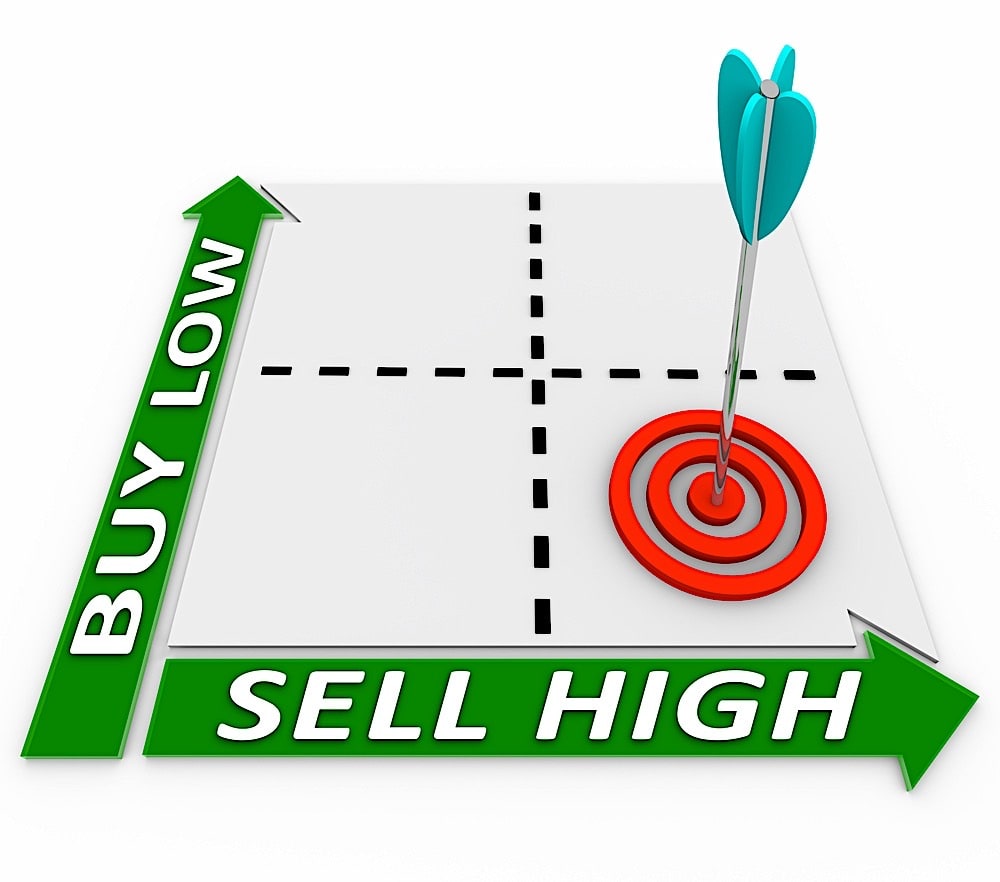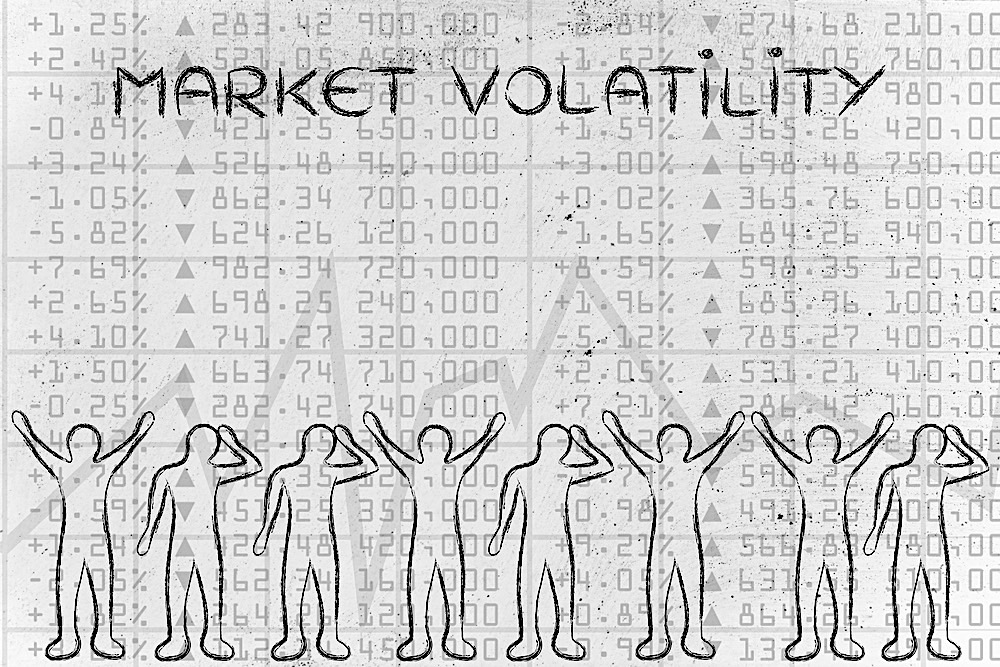“Buy Low, Sell High” is preached about so often by investors that it’s almost become a cliche. The mantra may sound a little too simple and obvious, and, sure enough, this investment strategy requires more strategizing than you’d expect. This investor’s guide will teach you the simplicities and intricacies of “buy low, sell high” investing.
What is the “Buy Low, Sell High” Strategy?
The “Buy Low & Sell High” investment strategy is all about timing the market. You buy stocks when they’ve hit a bottom price, and you sell stocks when their price peaks. That’s how you can generate the highest returns.
You buy a stock when the price is very low—say, $50. When the price peals, you sell that stock for $100. You’ve just earned a 100% return on investment.
The Buy Low & Sell High strategy is based on the nature of stock market cycles. In other words, it’s intended to help you capitalize on the fact that stock market prices naturally fluctuate.
Stock market prices fluctuate for a variety of reasons, including:
- World events
- Corporate changes
- Overall economic health
These events may cause a company’s stock prices to rise or fall.
Herd Instinct
There’s quite a bit of psychology that goes into the stock market, particularly when it comes to “herd instinct.” Herd instinct is when large groups of investors react in the same way to real or perceived risk factors.
For example, let’s assume that a successful CEO announces she’ll leave the company at the end of the year. Because the company’s growth mostly occurred under her tenure, the investors believe that its profits will decline in her absence. Many investors begin selling stock in the company, which causes the stock price to fall.
Of course, just because the CEO is leaving doesn’t mean the company is going to fail. It’s possible that the CEO has developed a strong growth plan for the company or that the company has chosen a capable successor.
You recognize that the company will probably be fine, and you jump on the opportunity to buy shares at a low price. Next year, when the company generates record sales, the stock price rebounds, and you’re able to sell your shares for far more than what you bought them for.
Herd instinct is a powerful influence on short-term investors. But if you can be mindful enough to avoid that instinct, you could potentially capitalize on those inevitable fluctuations in the market.
[ Thinking about investing in real estate? Register to attend a FREE online real estate class and learn how to get started investing in real estate. ]

How to Buy Low & Sell High In Stocks
Buy Low, Sell High is a deceptively tricky stock investment strategy. You never know when a stock price is going to hit its highest or lowest point. If you try and determine the latest point to buy/sell, you’re probably going to miss your window. It’s better to determine the earliest point you can buy/sell.
So how do you know when prices have dropped far enough to constitute a buy? And how do you know prices have risen enough to warrant a sell?
Investors use moving averages to help them figure out whether a stock price is sufficiently low or high.
Investors commonly use two moving averages:
- 50-Day Moving Average: Tracks the short-term performance of a stock over the last 50 days
- 200-Day Moving Average: Tracks the long-term performance of a stock over the previous 200 days
There are two different ways you can use these averages.
The Conventional Approach
Here’s the approach taken by most investors:
- Buy shares when the 50-day average rises above the 200-day average
- Sell shares when the 50-day average falls below the 200-day average
If the 50-day average is higher than the 200-day average, it’s a signal that the stock price is rising significantly. If you purchase shares now, they’re probably going to grow in value.
Let’s take a look at the averages for Target Corporation (as of a single day in January 2021):
- 50-Day Moving Average: 174.84
- 200-Day Moving Average: 142.33
You can see that the 50-Day Moving Average has risen higher than the 200-Day Moving Average, so that’s a signal that if you buy now, your shares are more likely to increase in value going forward.

The Converse Method
If you’re trying to maximize your returns, you could employ the reverse method:
- Buy shares when the 50-day average falls below the 200-day average
- Sell shares when the 50-day average rises above the 200-day average
The logic is that when stock prices are falling, you can buy a greater number of shares for a lower price. If those stocks rebound, you can sell all those shares for a massive return on investment.
Let’s change up those Target numbers:
- 50-Day Moving Average: 98.32
- 200-Day Moving Average: 142.33
In this example, the 50-Day Moving Average has fallen beneath the 200-Day Moving Average, which signals a significant drop in value. You jump on this opportunity to buy 10 shares (for $983.20 instead of $1423.30—you save $440.10).
If the stock rebounds to $150, you could sell your 10 shares for $1500.
You will have profited (1500 – 983.20 ) $516.80.
Not a bad return for a single company! String together a few similar investments, and you’ll have a significant passive income.
The big question, though, is whether or not the stock is going to rebound. If it does, then you can make a lot of money. If it doesn’t, you could lose a lot of money.
Challenges Of Buy Low, Sell High In Stocks
As a stock investor, the biggest challenge is determining the best time to buy low and sell high. Market trends have proven on several occasions to be deceiving — the right time to buy low and sell high must be determined by their own objective methods.
In the late 1990s, the internet bubble proved to be an excellent opportunity for investors. Those who guided their investments by this trend were sure internet stocks would continue to rise endlessly in 1999. The market crash of 2008 influenced investors to think the housing industry would never recover. Sellers of internet stocks and buyers of housing stocks initially regretted their decisions during these periods of intense fluctuations. However, they were shortly proven wrong as the trends began to move in the opposite direction.
The best investors know that trends are only one piece of an ever-changing puzzle. They know when to ignore trends and follow their own method when deciding to incorporate a buy low, sell high strategy.
The Importance of Stock Research
As you can see, how much a stock price changes is not as important as why it’s changing.
The numbers aren’t going to tell you the entire story about a company’s financial prospects. You must do substantial stock research so you can better understand which direction a company is headed.
Regardless of whether you buy stocks that are rising or falling in price, you want the company you’re buying shares in to maintain its growth. That’s why you should look into several different facets of the company—financials, leadership, growth plan, and more. Read our guide on how to do stock research for a deep dive.
Pros of Buy Low, Sell High
The benefits of Buy Low & Sell High are pretty obvious:
- You could generate very high returns, if successful
- You’re more likely to outperform the market then if you were investing in mutual funds
- You could buy a lot of stock for a lower price
Cons of Buy Low, Sell High
Buy Low, Sell High is a simple mantra, but it’s challenging to practice. This investment strategy is based on the principle of “timing the market,” which is difficult to do, even for experienced investors.
There are three major problems with Buy Low, Sell High:
- Hard to predict when to buy or sell
- Hard to predict whether a company will grow
- Easy to get caught up in herd instinct
The first problem is that it’s hard to predict when stock prices will bottom out or peak. You’re waiting for a buying or selling window that’s very brief and which can arrive at a moment’s notice. If you miss that window, you can fail to generate sufficient returns on your investment.
The second problem is that there’s always uncertainty about whether or not stock prices will grow significantly after you’ve purchased shares. You might get excited about purchasing stock in a company where share prices are falling. But stock prices could be plummeting because the company is failing and headed toward bankruptcy. That may not be a good basket to put your eggs in.
Even if you buy shares in a rapidly growing company, who knows how long that company will generate high revenue? You can do stock research on the company, but that’s more of an art form than a science. There’s just no sure way of knowing exactly when to buy and when to sell.
The third problem is that you could get caught up in herd instinct. Herd instinct is infectious, especially after you’ve made your first stock purchase and you have money at stake. Are you confident that you can make objective investment decisions?

How to Buy Low, Sell High In Real Estate
Buy Low, Sell High is arguably a more effective investment strategy for real estate. That’s because most properties in the United States tend to appreciate in value. When you purchase a property, you have more confidence (not certainty—just confidence) that it will grow in value.
There are six ways you can incorporate Buy Low, Sell High into your real estate strategy:
- Follow Market Cycles
- Research Buyers and Sellers Markets
- Look for Out-of-State Opportunities
- Consider Buy-and-Hold Properties
- Fix-and-Flip
- Keep Up With Your Local Market
1. Follow Market Cycles
Like the stock market, the real estate market goes through cycles. Prices rise to a peak, fall to a bottom, and then rise to a peak.
These price fluctuations allow you to buy property when prices are low and sell the property when prices are high.
2. Research Buyers & Sellers Markets
There are two types of markets in real estate:
- Buyer’s Market: Prices are falling, lots of homes are being listed, listed properties are spending many days on the market, and closing costs are low
- Seller’s Market: Prices are rising, inventories are falling, listed properties are only on the market for a short time, and closing costs are high
If you’re planning on purchasing property, time your investment strategy so that you’re able to purchase during a buyer’s market.
On the flip side, time your strategy so that you can sell properties during a seller’s market.
Adhering to these principles will help you maximize your savings and earnings.
3. Look For Out-of-State Opportunities
To be a successful real estate investor, you need to keep purchasing properties. Sometimes you can’t wait for your local market to become a buyer’s market. If it’s going to remain a seller’s market for the foreseeable future, you should try looking at a different real estate market that’s in another county or state.
It’s difficult and risky to purchase property that’s outside your local market. There are lots of extra costs involved (like traveling to that market to do property inspections), and you might not be as familiar with these markets as you are with your local one. This means you can more easily miss red flags or good opportunities.
Still, you can grow your wealth faster by taking advantage of buyer’s or seller’s markets in other areas. Just do a lot of research on that market before you buy or sell.
4. Consider Buy-and-Hold Properties
Most properties will not appreciate in value right away—it can take years for a property to grow significantly in value. If that’s the case, you can always hold your property for a longer period and rent it out to tenants or vacation renters (known as a “buy-and-hold” strategy).
This is one of the best real estate investment strategies because you’ll give your property ample time to appreciate, and you’ll also earn extra money that you can use to pay off the mortgage or to pocket as a passive income.
5. Fix-and-Flip
Buy Low, Sell High is the main principle behind house flipping. A fix-and-flip property is a property that you buy for a low price—usually because it’s a fixer-upper. You do renovations on the property to increase the value, and then you sell it for a significantly higher price.
This is an excellent real estate strategy because you don’t need to wait for the market to change—you can improve the property value in just a few months.
Just be careful not to spend too much money on your renovations, or else you’ll be eating into your profits (read our guide on house flipping for a deep dive).
6. Keep Up With Your Local Market
If you’re going to take advantage of buyer’s and seller’s markets, you need to be mindful of what’s going on in your local market. Always know what’s happening around your city, county, and state so you can prepare your investment strategy accordingly.
Bookmark those real estate news websites and network as much as you can with other professionals so you can share insights.

Alternatives to Buy Low, Sell High
Buy Low, Sell High is mostly a strategy for short-term investors who are trying to generate significant profits within just a few years. Short-term investing is much riskier, and you should try and develop a diverse investment portfolio to mitigate some of the risks that come with individual stocks.
If you’re a long-term investor (e.g., you’re saving for retirement), you might be better off
investing in ETFs, index funds, or mutual funds. These investments won’t outperform the market like stocks can, but they’ll generate safer, more consistent returns.
Another option is to prioritize dollar-cost averaging — or continually investing over time. This strategy essentially helps investors even out losses by investing throughout markets changes.
A final alternative to consider, though certainly not the last investment option available, is a dividend reinvestment plan. This strategy is for investors who own dividend-paying stocks, and re-enroll payouts back into the same stock. The goal is to help even out losses over time while maximizing benefits from the stocks.
If you do plan on trying your hand at Buy Low, Sell High, just remember to do adequate stock research so that you’re making informed decisions.
Summary
Buy Low, Sell High is an investment strategy in which you buy stock when prices are at a low point and sell stock when it reaches a high point. You can use moving averages to help you determine when to buy or sell, but you should also do stock research to determine whether or not a company’s profits are likely to rebound. Buy Low, Sell High is a risky investment because market behavior is impossible to predict. It’s a safer strategy when employed with real estate because most properties are bound to grow in value.
Ready to start taking advantage of the current opportunities in the real estate market?
Click the banner below to take a 90-minute online training class and get started learning how to invest in today’s real estate market!
FortuneBuilders is not registered as a securities broker-dealer or an investment adviser with the U.S. Securities and Exchange Commission, the Financial Industry Regulatory Authority (“FINRA”), or any state securities regulatory authority. The information presented is not intended to be used as the sole basis of any investment decisions, nor should it be construed as advice designed to meet the investment needs of any particular investor. Nothing provided shall constitute financial, tax, legal, or accounting advice or individually tailored investment advice. This information is for educational purposes only is not meant to be a solicitation or recommendation to buy, sell, or hold any securities mentioned.


